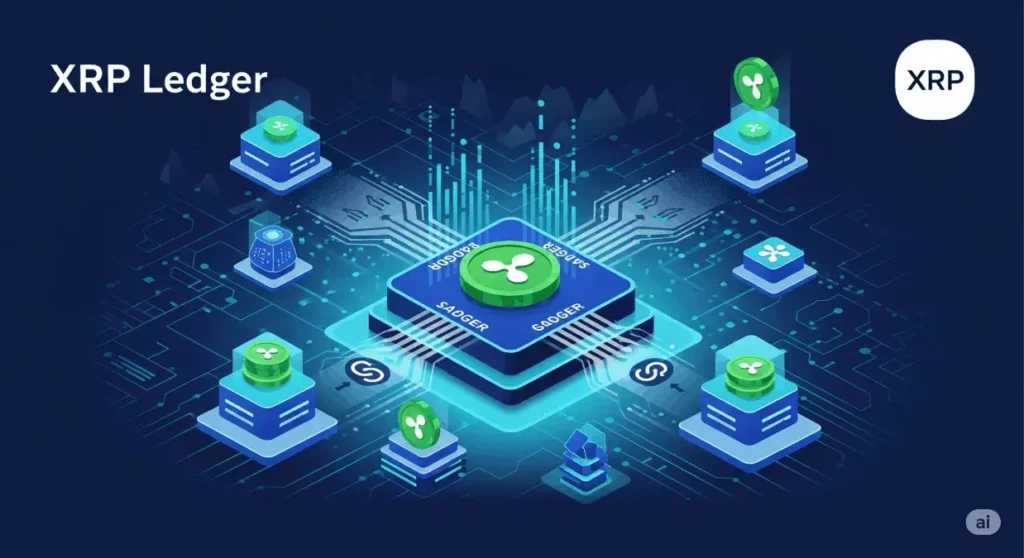XRP Ledger: A Deep Dive into Surging Metrics and Institutional Adoption

The XRP Ledger ecosystem is currently experiencing a significant surge across multiple vital metrics, signaling a robust and evolving landscape for the digital asset. This isn’t merely a fleeting trend but a clear indication of broadening adoption and increasing confidence from both retail participants and, more notably, institutional players. The data paints a compelling picture of an asset solidifying its position in the broader financial ecosystem, moving beyond its historical reputation primarily as a vehicle for cross-border payments.
Unprecedented Activity on the XRP Ledger
Recent data from Santiment reveals a dramatic spike in daily active addresses on the XRP Ledger, soaring past 295,000. This figure is exceptionally high, dwarfing the average of 35,000 to 40,000 seen over the preceding three months. Such a sharp rise is a powerful indicator of expanded utility and engagement with the XRP Ledger. It suggests that more individuals and entities are actively interacting with the network, executing transactions, and leveraging its capabilities. This surge in activity is not just speculative; it reflects a genuine increase in the usage of the XRP Ledger for a variety of purposes.
This heightened activity on the XRP Ledger is a multifaceted phenomenon. While retail participants undoubtedly contribute to these numbers, the driving force appears to be a more diverse group, including financially motivated players and even institutional entities. These institutions are increasingly recognizing the efficiency and cost-effectiveness of XRP for liquidity management and cross-border transfers. The inherent speed and low transaction fees of the XRP Ledger make it an attractive option for large-scale value movements, a core use case for which XRP was originally designed. The burgeoning interest demonstrates a growing understanding of the XRP Ledger’s potential beyond just trading.
Whales Accumulate: A Sign of Institutional Confidence
Perhaps one of the most telling signs of growing institutional trust is the unprecedented increase in the number of wallets holding at least 1 million XRP. For the first time in XRP’s 12-year history, this number has reached 2,700. Each of these “whale” wallets, as they are often called, holds roughly $2.25 million in value, representing a substantial commitment. This accumulation by high-net-worth individuals and institutional investors stands in stark contrast to the general trend of capital outflows observed in many other cryptocurrencies. It suggests a strategic long-term view, with these significant holders positioning themselves for future growth and utility within the XRP Ledger ecosystem.
This influx of capital into XRP investment products further underscores this growing institutional confidence. Over $11 million in net inflows entered XRP investment products during the last week alone. This inflow indicates that professional investors and wealth managers are actively seeking exposure to XRP through regulated and accessible investment vehicles. This trend is crucial for the maturation of any digital asset, as it brings in more stable and substantial capital, reducing volatility and fostering long-term development.
Institutional Growth and New Integrations: Expanding XRP’s Horizon
The momentum for XRP is not just driven by on-chain metrics; a series of significant institutional developments and strategic integrations are further strengthening XRP’s outlook. These developments collectively paint a picture of an ecosystem that is rapidly expanding its reach and utility.
A landmark development for the XRP Ledger and its native asset is the upcoming launch of Canada’s first XRP ETF, managed by Purpose Investments, scheduled for June 18, 2025. This move is monumental as it provides regulated and accessible exposure to XRP for a broader range of investors, including those in traditional financial markets. Purpose Investments has a strong track record, having launched the world’s first spot Bitcoin ETF in Canada, and their foray into XRP signals a clear belief in the asset’s legitimacy and long-term potential. This ETF will be available in multiple formats, catering to various investor preferences and allowing for tax-advantaged holding in registered accounts. The approval of such a product in a G7 nation is a strong endorsement and could pave the way for similar offerings in other jurisdictions, notably the United States, where XRP ETF filings are also pending with the SEC.
Complementing this, XRP’s integration with the Lace wallet, built by developers from the Cardano ecosystem, highlights the increasing interoperability and collaborative spirit within the blockchain space. This integration allows users to seamlessly manage their XRP alongside other assets, enhancing user experience and liquidity across different chains. This cross-chain collaboration is vital for fostering a more interconnected and efficient crypto landscape.
Furthermore, there is growing interest in utilizing Ripple’s RLUSD stablecoin for emerging DeFi products. RLUSD, a dollar-pegged stablecoin, aims to combine the stability of fiat with the efficiency of blockchain technology. Its integration into DeFi protocols, as seen with Aave, signifies a crucial step towards expanding XRP’s utility within the decentralized finance sector. This allows for new opportunities such as liquidity provision, efficient trading, and lending/borrowing using a stable, regulated asset on the XRP Ledger.
Beyond stablecoins, ongoing efforts to build bridges between Ethereum and the XRP Ledger are underway. The XRP Ledger is set to launch an Ethereum Virtual Machine (EVM)-compatible sidechain in Q2 2025, developed by Ripple and Peersyst Technology. This development will be a game-changer, allowing developers to leverage Ethereum’s robust smart contract capabilities and popular tools like Solidity and MetaMask within the XRP Ledger ecosystem. Wrapped XRP (wXRP) will serve as the native gas token, facilitating seamless asset transfers via the Axelar network. This interoperability could significantly improve overall ecosystem liquidity and unlock a vast array of new DeFi applications and use cases for XRP, drawing in developers and users from the expansive Ethereum community.
Corporate Adoption and Market Expert Endorsements
The institutional embrace of XRP is also evident in the strategic reserve holdings of publicly traded companies. Worksport and VivoPower are notable examples, having already added XRP to their corporate treasuries. Worksport, a company focused on automotive and clean energy, has committed $5 million towards building its XRP treasury, while VivoPower International, a sustainable energy solutions provider, has allocated $100 million of a recent funding round towards XRP, with plans to stake it on the Flare Network for yield generation. These moves highlight a shifting paradigm where companies view XRP not just as a speculative asset, but as a legitimate and valuable component of their financial strategies, leveraging its utility for liquidity and potential yield.
Moreover, prominent market experts are publicly acknowledging the institutional readiness of XRP. Fabian Dori, Chief Investment Officer at Sygnum Bank, a regulated digital asset bank, points to clear signs of this readiness. He cites the upcoming launch of XRP futures on the CME, which officially began trading in May 2025, and the potential for ETF approvals for both XRP and Solana. The CME’s entry into XRP futures provides regulated derivatives products, further validating XRP as a legitimate asset class for institutional investors to manage risk and gain exposure. These endorsements from established financial institutions and their leaders significantly contribute to mainstream acceptance and trust in the XRP Ledger.
Room for Growth: DeFi on the XRP Ledger
Despite the impressive strides in active addresses, institutional adoption, and new integrations, there are still areas where the XRP Ledger ecosystem has room for improvement, particularly in the realm of decentralized finance (DeFi). According to DeFiLlama, the total value locked (TVL) on the XRP Ledger remains relatively modest, sitting around $60 million. Similarly, decentralized exchange (DEX) volumes rarely exceed $100,000 per day.
These figures indicate that while the core utility of the XRP Ledger for payments and cross-border transfers is strong, its current role in the broader DeFi landscape is still limited compared to other leading smart contract platforms. The XRPL’s architecture, traditionally optimized for speed and efficiency in payments, has historically lacked the built-in features for complex DeFi activities like sophisticated smart contracts, extensive lending, and borrowing protocols, or a wide variety of Automated Market Makers (AMMs). Currently, there is a relatively limited selection of DeFi solutions directly on the XRP Ledger.
However, this is precisely where the ongoing developments come into play. The introduction of an EVM-compatible sidechain and the growing interest in utilizing RLUSD for DeFi products are directly addressing these limitations. The ability to deploy Ethereum-compatible smart contracts on the XRP Ledger will unlock a vast new frontier for DeFi applications. Developers will be able to build a wider range of lending protocols, yield farming opportunities, and other innovative financial products, attracting significant new capital inflows. The continuous auction mechanism in the XRPL’s AMM, which integrates directly with its native order book, also aims to optimize trade execution and mitigate impermanent loss, making liquidity provision more appealing to institutional players.
With these advancements, coupled with the increasing institutional interest and capital inflows, the DeFi landscape on the XRP Ledger is poised for significant expansion. The potential for new and innovative DeFi applications built on the XRPL will drive further adoption and cement XRP’s position as a multifaceted digital asset in the evolving financial world. The future promises a more vibrant and comprehensive decentralized finance ecosystem on the XRP Ledger, solidifying its role in the digital economy.
Stay informed, read the latest crypto news in real time!
Conclusion: A Promising Future for XRP
The recent surge in key metrics, coupled with significant institutional advancements and strategic integrations, paints a highly optimistic picture for the XRP ecosystem. The dramatic increase in daily active addresses on the XRP Ledger, the record number of “whale” wallets, and substantial investment product inflows all point towards a growing and diversifying user base.
The launch of Canada’s first XRP ETF, the ongoing efforts to bridge the XRP Ledger with Ethereum, and the expanding utility of Ripple’s RLUSD stablecoin are critical milestones that will undoubtedly accelerate XRP’s mainstream adoption and DeFi integration. As more public companies follow suit in adding XRP to their strategic reserves and market experts continue to validate its institutional readiness, the asset’s credibility and perceived value continue to grow.
While the DeFi ecosystem on the XRP Ledger still has ample room to flourish, the foundational developments are firmly in place to support this expansion. The combination of its established strengths in payments, coupled with its evolving capabilities in decentralized finance, positions XRP for a significant role in the future of digital finance. The XRP Ledger is not just a platform for fast and cheap payments; it’s rapidly transforming into a comprehensive blockchain ecosystem attracting a wide array of participants and use cases.





2 thoughts on “XRP Ledger: A Deep Dive into Surging Metrics and Institutional Adoption”